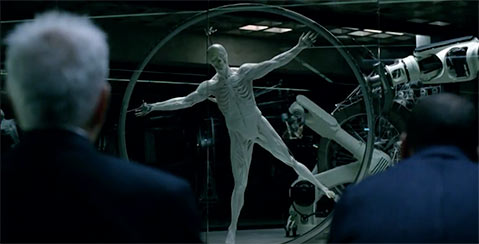‘Westworld’: It’s the Scary Future
Guns and Robots Collide in HBO’s Series

Of course it’s impossible to predict Westworld’s arc, its maker’s intentions, or even what might happen in this year’s 10-episode season, but at last, after the third installment, it finally feels like something complex and intellectually chewy will take place in HBO’s new flagship series.
Based loosely on the mediocre 1973 Michael Crichton film about scary theme park immersion in an automated Wild West, the first two installments of the remake weren’t much more than expositions for a procedural. A day (or two) in the “lives” of a number of characters who populate the futuristic theme park — though we never actually learn when and where the action takes place — reveals a pattern of repeated moves by the robot “hosts,” and some surprising improvisations. Real people come and go, too, in the spectacular settings, a distillation of John Ford’s Monument Valley with a lab underneath it — like The Cabin in the Woods on a massive scale. We quickly discover that it’s hard to sort out the grouchy real people from the automatons whose complex programming seems ripe to spill over into actual consciousness. And after a few episodes, that seems to be the point.
The best characters thus far are two robots and three humans — though many more creatures wildly emote around them. On the robotic level is a sort-of couple: Dolores Abernathy (Evan Rachel Wood), a sexy yet prim rancher’s daughter doomed to a violent-ending plot and Teddy Flood (James Marsden), a psychologically self-tortured hero who sometimes saves Dolores. His backstory, it seems, has been left vague by the prime makers who are (chiefly) Bernard Lowe (Jeffrey Wright) and Dr. Robert Ford (Anthony Hopkins), both with swirly dark pasts of their own. Just outside these sets are Maeve Millay (Thandie Newton), a B-girl bot who seems to be waking up on her own, and Theresa Cullen (Sidse Babett Knudsen), an administrator held in thrall by some mysterious drive we don’t yet get.
And then comes Ed Harris as the Man in Black standing in for the movie’s Yul Brynner malignancy. Who knows what he is? As story paths wear like dusty trails, we learn that Dr. Ford has unleashed an experiment that makes the hosts look like they are perpetually pondering some big question. Apparently, though, it works. Old programs rub up against new stories, and the robots are getting restless.
That stuff is pretty fun, though the suspense isn’t exactly vibrant. I get a nagging feeling that the writers just stepped out of an academic seminar on narrative and trauma, and it feels as if the show is being pitched to grad students instead of sci-fi fans. It’s beautiful, violent, and complicated, but there’s little to suggest this might catch the public imagination like Game of Thrones has done.
Westerns are usually about death, from tombstone shootouts to riding into the West. But moving toward some consciousness apocalypse isn’t quite the same thing as gunslinger reckonings, and the high noon we’ll get in Westworld isn’t Boot Hill — it’s the scary future.



